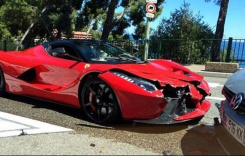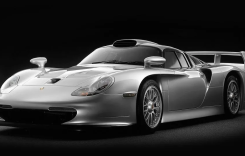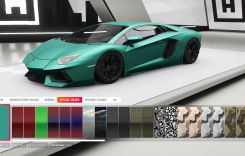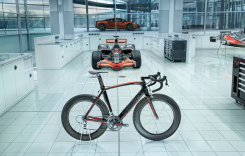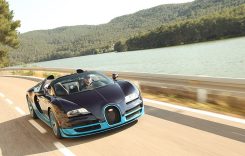Entry-level motorcycles have gained traction in the recent years, as manufacturers court new ridership with affordable, small-displacement mounts that still deliver practical performance. Suzuki Motor Company adds another entry to the class with its all-new GW250 naked standard. Suzuki chose the AIMExpo in Orlando to give the media its first sampling of the GW, with MotoUSA along for the ride.

Branded as the Inazuma 250 outside of the US market, the GW250 took its sweet time arriving in the States. Having debuted at the company’s dealer show last year, the 2013 model is just now hitting the sales floor as Suzuki finally settled on its $3999 MSRP.
Suzuki well deserves budget bike status with its sub $4K price tag. It undercuts its nearest rival, Honda’s CBR250R, by $200 (even more factoring Honda’s $310 destination charge). Remarkably, the GW250 is also more affordable than its fellow entry-level Suzuki kin, the $4399 TU250X – an older retro-styled 249cc Single that is currently not for sale in California because of emission regulations.
A liquid-cooled Parallel Twin powers the GW, with a single overhead cam actuating the two-valve cylinder heads. The undersquare engine incorporates a 53.5mm bore and 55.2mm stroke to displace 248cc. Suzuki claims 24 horsepower from its little GW mill, with peak torque 16.2 lb-ft. Neither stat gets the better of its 250 rivals from Honda and Kawasaki – with Suzuki’s own data rating the CBR250 at 26 hp/16.89 lb-ft and Ninja 250 at 32.1 hp/16.2 lb-ft (the Ninja 300 claiming an even bigger advantage).

On the road the GW250 engine performance is most reminiscent of the older Ninja 250, with the real power kicking in up high. But, unlike the Ninja, the GW doesn’t rev to the moon – instead topping out at 11,000 rpm. Riding 40 miles, give or take, on Orlando surface streets and freeways, our tach consistently stayed up between 8-11K.
Off the bottom there ain’t a whole lot of beans on tap, but the Suzuki revs quick and throttles up to speed just fine. I topped out on the freeway at 81 mph – and could have gone faster with more open space, but not much more. Freeway performance is capable enough, though passing power above 70 mph takes some time.
A gear-driven balancer shaft does an effective job keeping the GW’s Twin from getting too buzzy. At the higher rpm that it prefers the vibrations do manifest – but nothing egregious. In our estimation it’s on par with the CBR250R in this regard.
For novice riders, the engine’s best feature is its forgiving throttle and smooth fueling. Even purposely hamfisted inputs saw the fuel-injected GW meter out a drama-free linear power delivery. It’s a completely unintimidating engine package.
The six-speed transmission is another highlight for the GW. The clutch engages with reassuring feel at the lever and the bike is mindlessly easy to launch. A well-sorted gearbox ensures confident shifts, and neutral is super easy to find – a trait that more expensive and refined bikes would have trouble replicating. Oh, and the GW always lets riders know what gear they are in thanks to the handy gear position indicator on the dash (more on this later).
As far as handling goes, our best corners in Orlando were preceded by Exit # signage, so it’s difficult to say how the GW250 will perform during spirited backroad jaunts. The few turns I did encounter, and later simulated in the convention center parking lot, saw the Suzuki turn-in reasonably quick – perhaps not as fast as its quick-turning CBR and Ninja rivals, but maybe less twitchy too. In motion the bike doesn’t feel particularly heavy, but the GW’s 403 pound curb weight is somehow about 20 to 40 pounds more than its fully-faired 250/300 rivals.

The GW fares better for city use where its non-adjustable fork and seven-step preload adjustable shock, both from Kayaba, suck up the pavement. The settings are soft and springy but made for a comfortable and steady ride over poor and pristine surfaces alike during our sightseeing tour of Orlando metro sprawl – making the GW an ideal commuting platform.
A single-disc front brake pinched by two-piston Nissin calipers brings things to a halt with a stern squeeze on the lever. The rear brake plays its part too, though the IRC tire breaks loose with even a moderate stomp on the pedal (ABS not available even as an option). The underwhelming components get the job done, and I’ll cut the front brake some slack for the nice five-position lever adjustment.


Riding position on the GW will accommodate a wide range of riders. It’s a small bike, but at 6’1” I did not feel overly cramped at the controls. Credit goes to the handlebars, which are placed high and encourage an upright stance along with the footpeg placement. Suzuki is keen to note the 30.7-inch seat height is lowest in class (4mm shorter than the CBR), making for an easy each to the ground. I was more appreciative of the seat’s contours, which kept me from running forward into the tank, a pet peeve, and the perch proved comfortable for our admittedly brief stint in the saddle.
This new Suzuki is manufactured in China, carrying all the baggage such a designation implies. That said, fit and finish on the GW impressed. I found the controls and bodywork solid and sturdy. It doesn’t feel like a cheap, flimsy knockoff – instead it presents itself as a well-made machine. The instrument console is the highlight in this regard – with an analog speedo offset by several idiot lights on the left and an LCD display on the right. The latter incorporates a digital speedo and fuel gauge. Inset within the tach is another small LCD housing the gear position indicator, one of our personal favorites in a dashboard display and a real boon for novice riders too.
Some riders will not find it in themselves to stomach the GW’s styling. Suzuki claims the short-lived B-King inspired the GW250 lines, particularly evident in the headlight assembly. I’d say the little 250 is more an amalgam of the B-King and Gladius naked. Sure, the massive beak of a fender appears determined to wrap entirely around the front tire and don’t do the GW any favors, but overall I’d say the looks ain’t half bad. Then again, I liked the B-King too…
After a couple hours on the GW250 it showed true promise as an affordable entry-level platform and commuter bike. Whether it will outperform the CBR250R head to head is another matter, but it definitely fills a niche as the lone standard naked of the quarter-liter ranks in the US. Talking with a handful of the gathered Suzuki dealers in Orlando, they all seemed eager to have the GW, at last, as a counter against the affordable price-of-entries to Honda and Kawasaki.
The entry-level motorcycle class continues to grow and Suzuki has contributed a solid addition. While performance isn’t overwhelming, the GW250 is an inviting user-friendly platform to coax new riders into the Suzuki ranks. Add its lowest-in-class price point at $3999 and the GW could very well be a new staple for Hamamatsu.


